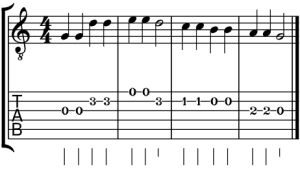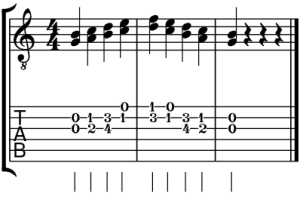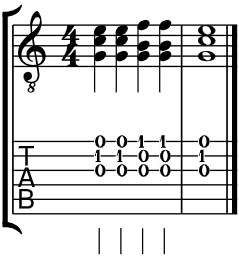As guitarists, we’ve all faced the challenge of learning how to read guitar sheet music. We often completely avoid this task by reverting to learning pieces by ear or even using tablature. While there are advantages to each of these approaches, they still have limitations of expression that can only be effectively communicated through standard notation.
However, if reading standard notation is so important to musicianship, then why do guitarists do their absolute best to avoid it? The answer is simple, reading guitar sheet music is difficult!
Easy Steps for Reading Guitar Sheet Music
There are so many more aspects of sheet music that we, as guitarists, need to be aware of other than the typical thoughts of “FACE in the Space” and “Every Good Boy Does Fine.” In this article, we will explore a few tips and tricks to help you better understand the idea of reading sheet music, while also providing a few things for you to practice to help build your reading skills.
On your guitar journey, you have most likely started reading sheet music in what we call “single note passages” or “single note melodies.” An example of this would include the song Twinkle, Twinkle Little Star:
With single note melodies, we are only focusing on playing one note on one string. This is a great place to start if you are a complete beginner with the guitar. Learning individual notes and their location on the fretboard is incredibly valuable to your skill set! However, it is the most basic practice for reading sheet music for the guitar and does not provide us with all of the information needed to play our favorite tunes. So we must dive into the world of reading harmonic intervals!
What are Harmonic Intervals and Why are They So Important?
Harmonic intervals are when we play two notes at the same time. These are also referred to as double stops. They allow us to provide an additional melody, or counter melody, to what is already being established. Harmonic intervals require us to read not one, but two notes at a time. This may seem complicated, but it can be simple if we approach it in ways that make sense! Let’s look at a few examples:
Notice that in the example above, we have the top line of notes and the bottom line of notes. These are our harmonic intervals. In this example, we notice that both the top and bottom lines are moving up and down in pitch at the same time. We refer to this idea as similar motion.
In the example below, we look at the opposite of similar motion, which is known as contrary motion. With contrary motion, the notes move in the opposite directions. One line ascends, or moves up in pitch, while the other line descends, or moves down in pitch.
The last example of harmonic intervals would be oblique motion. With oblique motion, we notice that one line stays the same, while the other either ascends or descends in pitch. This type of motion is common in the beginning stages of reading chords and chord melodies!
Chording Basics
Now, let’s dive into basic chording. Chording is when we stack harmonic intervals into what are known as 3rds. The stack of thirds produces a quality of sound. You’ve most likely heard of Major and Minor Chords. These names come from the chord quality. However, we are not really concerned with that idea for the time being. Let’s focus on the basic idea that chords are groups of more than two notes combined to create a specific sound.
In the example above, we notice that the chords are formed by groups of three notes. The chords formed are C and G7. These basic chords are commonly found in the beginning chord practices of most lesson books.
When looking at these chords, notice the types of motion that are present between the intervals. The top row of notes ascends in pitch from E to F, while the second row of notes descends from note C to B. This is a great example of contrary motion. If we compare those two rows to the bottom row of notes, we notice that the bottom row stays on note G throughout the entire example. We can identify this as an example of oblique motion.
When we consider all of these elements of reading guitar sheet music, we can easily understand why this task seems so challenging. However, with consistent deliberate practice, we can easily develop our reading skills and become a more efficient and well-rounded player.
Try practicing these techniques on some easier pieces of music, then move to more difficult chording practices. Remember, when reading guitar sheet music, we must look at chords as the products of motion, rather than simply relying on our ability to recognize the chord by name and shape.
Matthew West







